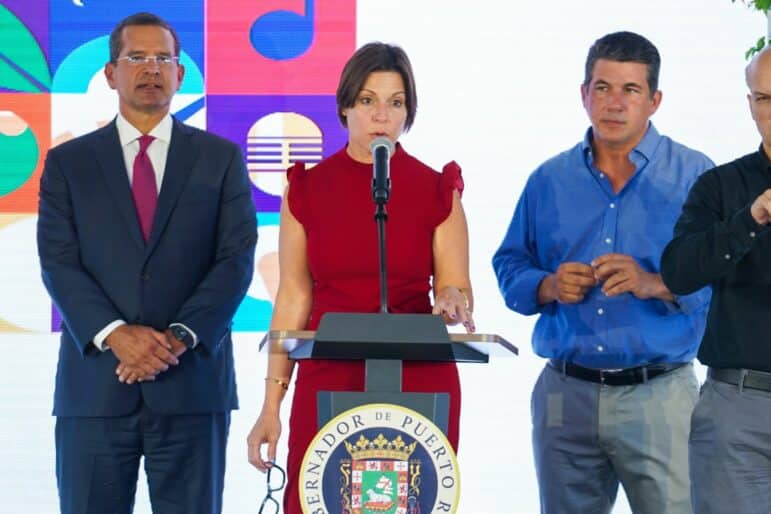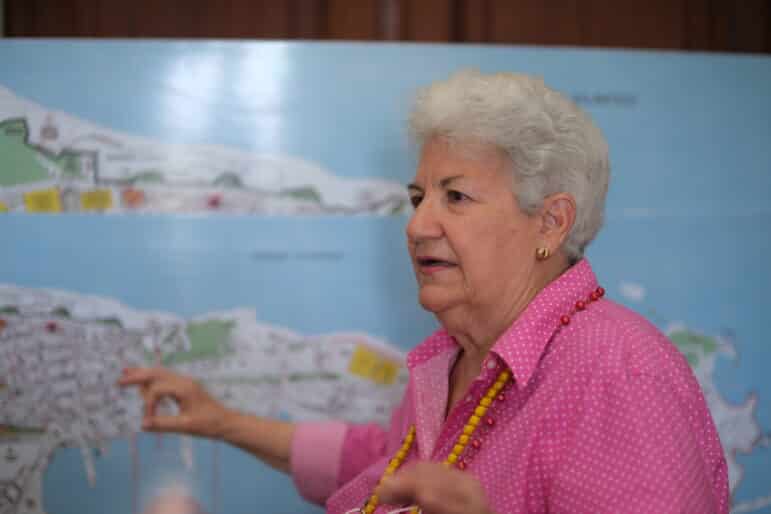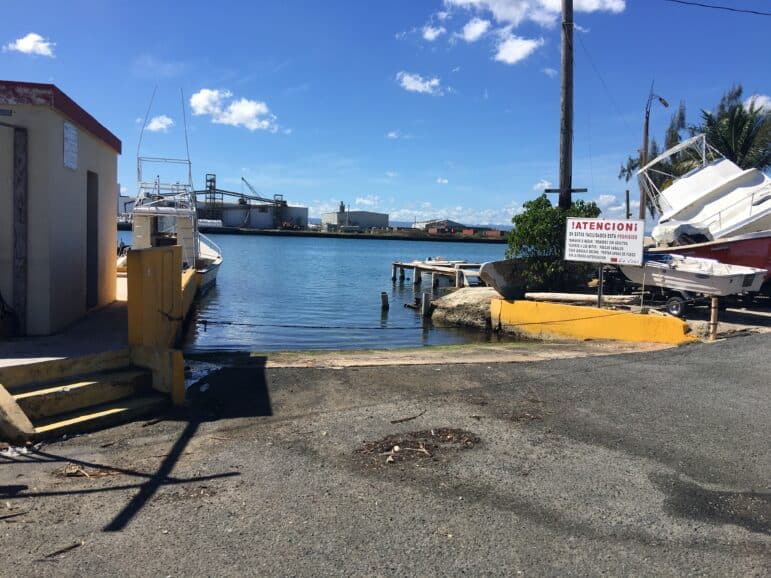The construction of a waterfront promenade, an ecological adventure park, an urban beach, handicrafts shops, street art, and an “authentic ‘chinchorro’ dining offering” are part of what is proposed to be built on piers 6, 7 and 8 of the San Juan Bay, which are in a flood zone, according to Federal Emergency Management Agency (FEMA) maps.
The lease for piers 6, 7 and 8 — known as Bahía Urbana — that the government of Puerto Rico granted to Funco LLC for at least 20 years will not only leave all the piers in San Juan Bay in private hands, but will also alter the landscape, infrastructure, and cultural narrative of the port area, as shown in documents produced by IDEAS, the US design firm hired to work on the proposed changes.
“We believe this development will set a new gold standard for cultural storytelling and redefine what a port destination can be,” the company said in a statement written by Bob Allen, Chief Storytelling Officer of IDEAS, who worked at Disneyland and is now responsible for developing narratives that grab the attention and provoke fascination about the businesses of the company’s clients.
In addition to piers 6, 7 and 8, there are two other projects that imply profound changes to the infrastructure of Old San Juan: the construction of a 1000 rooms Hard Rock hotel facing the bay, behind the Treasury Department; and the remodeling of piers 9 and 10 for luxury yachts.
In August 2022, the government announced a 30-year public-private partnership to modernize piers 1, 3, 4, 11 to 14 and the Pan-American I and II docks.
Puerto Rico for tourists short on time
The promoter of the project at piers 6, 7 and 8 and president of Funco LLC, Jacobo Ortiz Blanes, said the attraction is aimed mainly at tourists who arrive on cruise ships and who do not have much time to visit iconic places in Puerto Rico such as El Yunque rainforest, the beaches and the market squares. The private investment for this project will be $118 million.

(Courtesy photo)
Gov. Pedro Pierluisi said in a press conference when presenting and endorsing the project that Old San Juan annually welcomes more than three million residents of Puerto Rico and more than four million tourists.
Although the focus of this Funco LLC project is to build infrastructure that expands the offer of entertainment, retail, and tourism in these three piers, the Center for Investigative Journalism (CPI, in Spanish) interviewed people who live there or who have studied the area’s historical transformation and ecology and agree that the changes will have a negative impact on Old San Juan, as well as Puerta de Tierra and parts of Santurce.
Changes that entail environmental impact in the area
Coastal geomorphologist Mayra Román Rivera, believes some of the structures proposed by Funco, such as the floating islands, a forest and an “urban beach” would bring changes to the San Juan Bay’s marine species and ecosystems. The Puerto Rican scientist is concerned about the construction of this type of structure in an area that is already flood-prone and susceptible to strong tidal events.
“The floating islands don’t make sense to me. The concept that I know of coastal geomorphology, of floating islands, are islands that you make with vegetation. For example, you put bamboo, or some type of vegetation and the idea is conservation. But that also generates many problems because you introduce species that are invasive, you destroy nearby ecosystems,” Román Rivera said.
Meanwhile, Ortiz Blanes said the floating islands will be safe since they will be on non-permanent floating barges. He said the construction of an urban forest simulating El Yunque rainforest that will have a “river” running through it, will not adversely affect the area either.
However, the company has not yet initiated environmental impact statements. The executive said this process, as well as other permits, will be worked on starting in March.
“Piers 6, 7 and 8 have been heavily affected over the decades. We’re not impacting the ecosystem there because that has already been highly impacted,” Ortiz Blanes told the CPI in reference to the area that is accessed from Fernández Juncos Avenue in Puerta de Tierra.
However, geomorphologist Román Rivera believes Funco’s proposed construction would have adverse impacts on the area’s already affected ecosystem.
The professor in the Department of Geography and Sustainability at the University of Tennessee in Knoxville questioned the interest of building an area like El Yunque there, when the local climate and coastal ecosystems of San Juan Bay are completely different from those of that rainforest located in the island’s eastern region.
“The problem is that we want to build permanent structures on the coasts when the coasts aren’t permanent. It’s not that they shouldn’t build anything or fix the docks. It’s what they build that must be done thinking about aspects such as waves and floods. If you’re going to create a forest, why don’t you create a coastal forest with mangroves that will serve as a buffer?” she added.
The CPI contacted the San Juan Bay Estuary Program to get their perspective on these projects. However, through their press officer, they said they would voice their opinion after the environmental impact declaration documents are submitted. According to its website, the Estuary Program’s mission is to restore and conserve the water quality of the San Juan Bay Estuary ecosystem as a sustainable social and economic development hub.
Changes anticipated in Old San Juan’s economy, access
Changes like those proposed for San Juan Bay could exacerbate the shift in the area’s socioeconomic profile and change how people move around the islet and other parts of the capital, according to experts consulted.
Old San Juan real estate broker and long-time resident, Margarita Gandía, believes these ideas of renovating the ports district with new visions for how it should be used have been promoted for years by different government administrations of the Municipality of San Juan and the central government. The spokeswoman for the residents of the capital’s historic zone said the increase in the volume of shops near the docks, as the new projects in the Bahía Urbana area propose, could represent a drop in visits and consumption in Old San Juan.

Photo by Ricardo Arduengo | Centro de Periodismo Investigativo
“These projects [in Bahía Urbana] will turn Old San Juan into a ghost town, they’re going to kill it. Businesses in Old San Juan are going to move to the docks. If something should have been restored, it was Old San Juan so that people would come back and give it life, and create that mix between residences and businesses, not a museum city,” Gandía told the CPI.
“I call it a sort of mini-Disney,” said Gandía, referring to how she sees the concept of the project that Ortiz Blanes is promoting.
The lease to Funco is for $100,000 a year for up to 80 years. That number will jump by 5% every five years, and it will channel 3% of gross revenue to the Convention Center District Authority.
Ortiz Blanes also presides over Las Brisas Property Management, the company that appears on Bahía Urbana’s official website. Canadian company CapRock Partners is also part of the project.
Sharon Miranda, owner of Quimera, a business dedicated to physical and spiritual well-being on San José Street in Old San Juan, also shares the concern about the impact of these projects.
“The worrisome issue would be if this is a window that opens to perpetuate gentrification and that they’re foreign businesses, and that it isn’t going to support the Puerto Rican entrepreneurs. There will be an impact, because people are clustered in one area [the docks] and they don’t come to where we are [in Old San Juan],” Miranda told the CPI. “It’s wonderful when new businesses and new projects are promoted, but I believe that the priority should be to recover the historical heritage, which is what makes Old San Juan what it is,” she added.
Other vendors in Old San Juan see it differently. They believe these port projects will bring new opportunities for their businesses.
Pierre Dieufort, who owns a souvenir shop south of Tanca street, believes the proposed projects on the docks will bring economic stability to area businesses.
“I think it’s a great idea because the government is attracting business, and that will benefit us. Everyone is talking about what these developments on the docks can represent,” said the owner of the Nan and Steph Souvenir Shop.
In the alley, north of Calle Tanca, Isamar Rosado runs two businesses that specialize in fried foods and alcoholic beverages. The businesswoman is optimistic that people who visit the new projects in the southern part of the city will walk up the cobblestone streets to the North in search of the local experience that businesses like hers provide.
“It has been proven that when cruise ships arrive, even cruise ships arriving South of Old San Juan, people come up here [the North of the islet] and business activity is super remarkable,” said Rosado, who works as a manager of Antojitos del Callejón and El Adoquín del Patio.
She believes tourists use technology that guides them to the places to buy and eat all over the islet and that helps them not to stay only in the shops around the bay.
Ortiz Blanes shares this appreciation and believes that his project in Bahía Urbana will “add and not subtract from the Old San Juan experience.”
Concern among Old San Juan residents
But for Old San Juan resident and anthropologist, Jaime Pérez Rivera, this type of project presented by the government ― or by private companies ― often ignores the needs of people who have been living in the area for decades that will be affected by new infrastructure.
“People live on the San Juan islet. Not since yesterday, but people who have been there for several generations and have seen all these changes and transformations in the area. The [design] mock-ups don’t include people, or they include people with a profile that doesn’t match with the people who live in that area,” said the director of the Department of Sociology and Anthropology of the University of Puerto Rico’s Río Piedras Campus. The Funco project’s blueprints show no people.
Pérez Rivera said if Old San Juan is turning into a ghost town, it’s not necessarily because of the changes that have happened or will happen to the docks, but rather because of gentrification and property hoarding.
“They’ll start developing the docks and that’s going to increase property values. Someone who buys to live here is not the same as someone who buys to invest. There will also be more movement of people because there will be a demand from the tourism sector. There’s a domino effect. One thing leads to another,” the anthropologist said.
The proposed development of San Juan Bay reminds Gandía of the failed attempt to build a mega pier for Royal Caribbean Cruise Lines in 1999, during former Gov. Pedro Rosselló González’s administration. Like now, then the community opposition was also focused on the demand for the preservation of Old San Juan as a historic zone, as well as the promotion of orderly traffic to the entire islet of San Juan.
Gandía said the justification the government gave 24 years ago to promote the Royal Caribbean project is like what is proposed in the current project’s promotion: “We have no money, so we authorize them to carry out the projects.”
Access to the old city snarls
Isis Rodríguez, a resident of Old San Juan, is concerned about access and the increase in vehicular traffic because of these projects. For the 22-year-old woman, getting into the islet’s residential area is tough every time there are massive events. For that reason, she foresees more problems once big activities start to take place at the docks where the new projects are proposed.
“On a Saturday afternoon, we [residents] cannot drive up past El Capitolio (on the North side) because there’s simply too much traffic to get in. Now, when the constructions begin and these businesses begin to develop [on the docks in the South side)], then the traffic jam will be on both sides [North and South of the islet], and once again the Municipality of San Juan will forget about the residents of Old San Juan, Puerta de Tierra and La Perla,” Rodríguez told the CPI.
Ortiz Blanes said that he understands the residents’ concerns, but he does not believe that the projects will increase traffic since the target population is mainly “tourists who arrive on cruise ships” and not by car in the area.
“However, when this opens, the curious Puerto Rican is going to want to see, and yes, we’re going to have to deal with an initial spike. But the reality is that we don’t foresee that being the case,” he explained.
Steps away from the planned Bahía Urbana area project is a 1,000-room hotel complex, casino, and parking lot proposed under the Hard Rock Hotel & Casino brand, behind the Treasury Department building.
In 2016, the last year of former Gov. Alejandro García Padilla’s administration, the Puerto Rico Land Administration signed a long-term lease with an option to buy three lots of land with Plaza La Marina LLC, chaired by engineer Rubén Vélez Lebrón, and it is on that property that the hotel complex will be built.
The project, with an investment that exceeds $500 million, is in the permit management process, according to what Vélez Lebrón told CPI. The engineer also assured that the hotel area is not susceptible to flooding, although the FEMA map puts a part of the project in a flood zone.
The Advisory Base Flood Elevation maps, the most updated and developed by FEMA in conjunction with the Planning Board, puts the Treasury Department’s parking lot, where the hotel would be, in an area affected by storm surge.
“The design calls for raising the current level. It will come up at least one additional foot,” Vélez said about one of his strategies to face possible strong atmospheric events.
From fishing docks to luxury yacht hubs
Piers 9 and 10 in Puerta de Tierra, home to groups of fishermen and fishing settlements since before the middle of last century, today are an area where private yachts and mega yachts drop anchor. Ports Authority’s Executive Director, Joel Pizá Batiz, announced the selection of Safe Harbor Marinas LLC in January 2023 as the private entity that will remodel and manage both docks starting next year.
The Ports Authority is currently negotiating the contract with Safe Harbor Marinas LLC, so the terms cannot be disclosed, the agency told the CPI in written statements.
The vision of the agency, which owns the lands, promotes the zone’s transformation into a luxury area, which would have a communications center, gym and swimming pool for crew members and marina members.
One of the people who has witnessed the changes in the docks and the displacement of fishermen is Eugenio Ríos. At 70 years old, Ríos currently works at the San Juan Fish Market, on Hoare Street, an area where several fishermen from La Coal established themselves in the past.

Photo by Manuel Valdes Pizzini
Although Ríos was not directly involved in La Coal, his years of experience and ties with other fishermen in the so-called “Puente de la 10” area near Condado, paint a picture of the displacement to which those who practice their trade are exposed.
“Now everything around [the docks] belongs to those who have money. I go out in the boat, and they stop me to give me speed tickets. The yachts zip by at high speeds, and they don’t even bother them,” Ríos said about what he believes is a double standard from the government that favors people with yachts over those who work in the fishing industry.
The CPI reached out to Safe Harbor Marinas LLC by phone and email to request information about the proposed projects at Puerta de Tierra’s piers 9 and 10 but received no response. An interview was also requested, but the CPI did not get a response. Safe Harbor Marinas also manages the Marina Puerto del Rey, in Fajardo on the East coast.
Reporter Vanessa Colón Almenas, a corps member of Report for America, contributed to this story.
Próximo en la serie
2 / 2
San Juan Bay Area: Anchor for the Development of Private Projects
16 February 2023
¡APOYA AL CENTRO DE PERIODISMO INVESTIGATIVO!
Necesitamos tu apoyo para seguir haciendo y ampliando nuestro trabajo.


